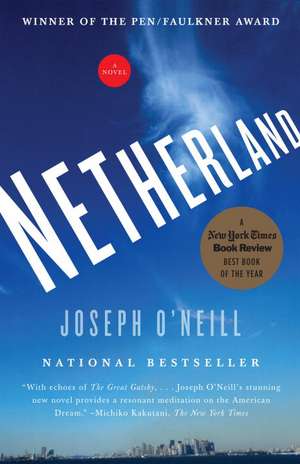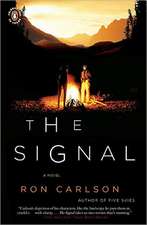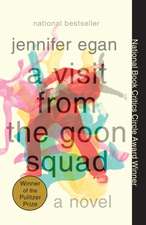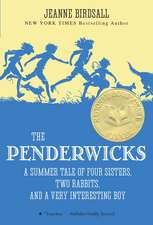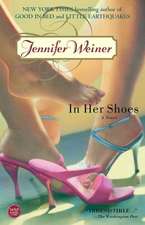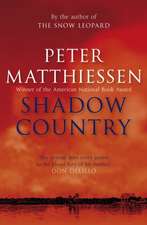Netherland
Autor Joseph O'Neillen Limba Engleză Paperback – 30 apr 2009
Vezi toate premiile Carte premiată
Indies Choice Book Awards (2009), PEN/Faulkner Award (2009), International IMPAC Dublin Literary Award (2010)
In a New York City made phantasmagorical by the events of 9/11, and left alone after his English wife and son return to London, Hans van den Broek stumbles upon the vibrant New York subculture of cricket, where he revisits his lost childhood and, thanks to a friendship with a charismatic and charming Trinidadian named Chuck Ramkissoon, begins to reconnect with his life and his adopted country. As the two men share their vastly different experiences of contemporary immigrant life in America, an unforgettable portrait emerges of an "other" New York populated by immigrants and strivers of every race and nationality.
Preț: 119.44 lei
Nou
Puncte Express: 179
Preț estimativ în valută:
22.86€ • 23.92$ • 19.02£
22.86€ • 23.92$ • 19.02£
Carte tipărită la comandă
Livrare economică 31 martie-14 aprilie
Preluare comenzi: 021 569.72.76
Specificații
ISBN-13: 9780307388773
ISBN-10: 0307388778
Pagini: 256
Dimensiuni: 133 x 202 x 20 mm
Greutate: 0.29 kg
Editura: Vintage Books USA
Locul publicării:New York, NY
ISBN-10: 0307388778
Pagini: 256
Dimensiuni: 133 x 202 x 20 mm
Greutate: 0.29 kg
Editura: Vintage Books USA
Locul publicării:New York, NY
Notă biografică
Joseph O’Neill was born in Cork, Ireland, in 1964 and grew up in Mozambique, South Africa, Iran, Turkey, and Holland. His previous works include the novels This Is the Life and The Breezes and the nonfiction book Blood-Dark Track, a family history centered on the mysterious imprisonment of both his grandfathers during World War II, which was a New York Times Notable Book. He writes regularly for The Atlantic Monthly. He lives with his family in New York City.
Extras
The afternoon before i left London for New York—Rachel had flown out six weeks previously—I was in my cubicle at work, boxing up my possessions, when a senior vice-president at the bank, an Englishman in his fifties, came to wish me well. I was surprised; he worked in another part of the building and in another department, and we were known to each other only by sight. Nevertheless, he asked me in detail about where I intended to live (“Watts? Which block on Watts?”) and reminisced for several minutes about his loft on Wooster Street and his outings to the “original” Dean & DeLuca. He was doing nothing to hide his envy.
“We won’t be gone for very long,” I said, playing down my good fortune. That was, in fact, the plan, conceived by my wife: to drop in on New York City for a year or three and then come back.
“You say that now,” he said. “But New York’s a very hard place to leave. And once you do leave . . .” The S.V.P., smiling, said, “I still miss it, and I left twelve years ago.”
It was my turn to smile—in part out of embarrassment, because he’d spoken with an American openness. “Well, we’ll see,” I said.
“Yes,” he said. “You will.”
His sureness irritated me, though principally he was pitiable—like one of those Petersburgians of yesteryear whose duties have washed him up on the wrong side of the Urals.
But it turns out he was right, in a way. Now that I, too, have left that city, I find it hard to rid myself of the feeling that life carries a taint of aftermath. This last-mentioned word, somebody once told me, refers literally to a second mowing of grass in the same season. You might say, if you’re the type prone to general observations, that New York City insists on memory’s repetitive mower—on the sort of purposeful postmortem that has the effect, so one is told and forlornly hopes, of cutting the grassy past to manageable proportions. For it keeps growing back, of course. None of this means that I wish I were back there now; and naturally I’d like to believe that my own retrospection is in some way more important than the old S.V.P.’s, which, when I was exposed to it, seemed to amount to not much more than a cheap longing. But there’s no such thing as a cheap longing, I’m tempted to conclude these days, not even if you’re sobbing over a cracked fingernail. Who knows what happened to that fellow over there? Who knows what lay behind his story about shopping for balsamic vinegar? He made it sound like an elixir, the poor bastard.
At any rate, for the first two years or so of my return to England, I did my best to look away from New York—where, after all, I’d been unhappy for the first time in my life. I didn’t go back there in person, and I didn’t wonder very often about what had become of a man named Chuck Ramkissoon, who’d been a friend during my final East Coast summer and had since, in the way of these things, become a transitory figure. Then, one evening in the spring of this year, 2006, Rachel and I are at home, in Highbury. She is absorbed by a story in the newspaper. I have already read it. It concerns a group of tribespeople that has emerged from the Amazon forest in Colombia. They are reportedly tired of the hard jungle life, although it’s noted they still like nothing better than to eat monkey, grilled and then boiled. A disturbing photograph of a boy gnawing at a blackened little skull illustrates this fact. The tribespeople have no idea of the existence of a host country named Colombia, and no idea, more hazardously, of diseases like the common cold or influenza, against which they have no natural defenses.
“Hello,” Rachel says, “your tribe has come to light.”
I’m still smiling when I answer the ringing phone. A New York Times reporter asks for Mr. van den Broek.
The reporter says, “This is about Kham, ah, Khamraj Ramkissoon . . . ?”
“Chuck,” I say, sitting down at the kitchen table. “It’s Chuck Ramkissoon.”
She tells me that Chuck’s “remains” have been found in the Gowanus Canal. There were handcuffs around his wrists and evidently he was the victim of a murder.
I don’t say anything. It seems to me this woman has told an obvious lie and that if I think about it long enough a rebuttal will come to me.
Her voice says, “Did you know him well?” When I don’t answer, she says, “It says somewhere you were his business partner.”
“That’s not accurate,” I say.
“But you were in business together, right? That’s what my note says.”
“No,” I say. “You’ve been misinformed. He was just a friend.”
She says, “Oh—OK.” There is a tapping of a keyboard and a hiatus.
“So—is there anything you can tell me about his milieu?”
“His milieu?” I say, startled into correcting her mooing pronunciation.
“Well, you know—who he hung out with, what kind of trouble he might have gotten himself into, any shady characters . . .” She adds with a faint laugh, “It is kind of unusual, what happened.”
I realize that I’m upset, even angry.
“Yes,” I finally say. “You have quite a story on your hands.”
The next day a small piece runs in the Metro section. It has been established that Chuck Ramkissoon’s body lay in the water by the Home Depot building for over two years, among crabs and car tires and shopping carts, until a so-called urban diver made a “macabre discovery” while filming a school of striped bass. Over the next week there is a trickle of follow-up items, none of them informative. But apparently it is interesting to readers, and reassuring to certain traditionalists, that the Gowanus Canal can still turn up a murder victim. There’s death in the old girl yet, as one commentator wittily puts it.
The night we receive the news, Rachel, in bed next to me, asks, “So who’s this man?” When I don’t immediately answer, she puts down her book.
“Oh,” I say, “I’m sure I’ve told you about him. A cricket guy I used to know. A guy from Brooklyn.”
She repeats after me, “Chuck Ramkissoon?”
Her voice contains an amused note I don’t like. I roll away onto one shoulder and close my eyes. “Yes,” I say. “Chuck Ramkissoon.”
Chuck and I met for the first time in August 2002. I was playing cricket at Randolph Walker Park, in Staten Island, and Chuck was present as one of the two independent umpires who gave their services in return for a fifty-dollar honorarium. The day was thick as a jelly, with a hot, glassy atmosphere and no wind, not even a breeze from the Kill of Kull, which flows less than two hundred yards from Walker Park and separates Staten Island from New Jersey. Far away, in the south, was the mumbling of thunder. It was the kind of barbarously sticky American afternoon that made me yearn for the shadows cast by scooting summer clouds in northern Europe, yearn even for those days when you play cricket wearing two sweaters under a cold sky patched here and there by a blue tatter—enough to make a sailor’s pants, as my mother used to say.
By the standards I brought to it, Walker Park was a very poor place for cricket. The playing area was, and I am sure still is, half the size of a regulation cricket field. The outfield is uneven and always overgrown, even when cut (once, chasing a ball, I nearly tripped over a hidden and, to cricketers, ominous duck), and whereas proper cricket, as some might call it, is played on a grass wicket, the pitch at Walker Park is made of clay, not turf, and must be covered with coconut matting; moreover the clay is pale sandy baseball clay, not red cricket clay, and its bounce cannot be counted on to stay true for long; and to the extent that it is true, it lacks variety and complexity. (Wickets consisting of earth and grass are rich with possibility: only they can fully challenge and reward a bowler’s repertoire of cutters and spinners and bouncers and seamers, and only these, in turn, can bring out and fully test a batsman’s repertoire of defensive and attacking strokes, not to mention his mental powers.) There is another problem. Large trees—pin oaks, red oaks, sweetgums, and American linden trees—clutter the fringes of Walker Park. Any part of these trees, even the smallest hanging leaf, must be treated as part of the boundary, and this brings randomness into the game. Often a ball will roll between the tree trunks, and the fielder running after it will partially disappear, so that when he reemerges, ball in hand, a shouting match will start up about exactly what happened.
By local standards, however, Walker Park is an attractive venue. Tennis courts said to be the oldest in the United States neighbor the cricket field, and the park itself is surrounded on all sides by Victorian houses with elaborately planted gardens. For as long as anyone can remember, the local residents have tolerated the occasional crash of a cricket ball, arriving like a gigantic meteoritic cranberry, into their flowering shrubbery. Staten Island Cricket Club was founded in 1872, and its teams have played on this little green every summer for over a hundred years. Walker Park was owned by the club until the 1920s. Nowadays the land and its clubhouse—a neo-Tudor brick structure dating back to the 1930s, its precursor having been destroyed by fire—are the property of the New York City Department of Parks and Recreation. In my time, a parks department employee, a phantom-like individual who was never seen, reportedly lived in the attic. The main room was rented out to a nursery school, and only the basement and the beaten-up locker room were routinely made available to cricketers. Nevertheless, no other New York cricket club enjoys such amenities or such a glorious history: Donald Bradman and Garry Sobers, the greatest cricketers of all time, have played at Walker Park. The old ground is also fortunate in its tranquillity. Other cricketing venues, places such as Idlewild Park and Marine Park and Monroe Cohen Ballfield, lie directly beneath the skyways to JFK. Elsewhere, for example Seaview Park (which of course has no view of a sea), in Canarsie, the setting is marred not only by screeching aircraft but also by the inexhaustible roar of the Belt Parkway, the loop of asphalt that separates much of south Brooklyn from salt water.
What all these recreational areas have in common are rank outfields that largely undermine the art of batting, which is directed at hitting the ball along the ground with that elegant variety of strokes a skillful batsman will have spent years trying to master and preserve: the glance, the hook, the cut, the sweep, the cover drive, the pull, and all those other offspring of technique conceived to send the cricket ball rolling and rolling, as if by magic, to the far-off edge of the playing field. Play such orthodox shots in New York and the ball will more than likely halt in the tangled, weedy ground cover: grass as I understand it, a fragrant plant wondrously suited for athletic pastimes, flourishes with difficulty; and if something green and grasslike does grow, it is never cut down as cricket requires. Consequently, in breach of the first rule of batting, the batsman is forced to smash the ball into the air—to go deep, as it’s said, borrowing the baseball term; and batting is turned into a gamble. As a result, fielding is distorted, too, since the fielders are quickly removed from their infield positions—point, extra cover, midwicket, and the others—to distant stations on the boundary, where they listlessly linger. It’s as if baseball were a game about home runs rather than base hits, and its basemen were relocated to spots deep in the outfield. This degenerate version of the sport—bush cricket, as Chuck more than once dismissed it—inflicts an injury that is aesthetic as much as anything: the American adaptation is devoid of the beauty of cricket played on a lawn of appropriate dimensions, where the white-clad ring of infielders, swanning figures on the vast oval, again and again converge in unison toward the batsman and again and again scatter back to their starting points, a repetition of pulmonary rhythm, as if the field breathed through its luminous visitors.
From the Hardcover edition.
“We won’t be gone for very long,” I said, playing down my good fortune. That was, in fact, the plan, conceived by my wife: to drop in on New York City for a year or three and then come back.
“You say that now,” he said. “But New York’s a very hard place to leave. And once you do leave . . .” The S.V.P., smiling, said, “I still miss it, and I left twelve years ago.”
It was my turn to smile—in part out of embarrassment, because he’d spoken with an American openness. “Well, we’ll see,” I said.
“Yes,” he said. “You will.”
His sureness irritated me, though principally he was pitiable—like one of those Petersburgians of yesteryear whose duties have washed him up on the wrong side of the Urals.
But it turns out he was right, in a way. Now that I, too, have left that city, I find it hard to rid myself of the feeling that life carries a taint of aftermath. This last-mentioned word, somebody once told me, refers literally to a second mowing of grass in the same season. You might say, if you’re the type prone to general observations, that New York City insists on memory’s repetitive mower—on the sort of purposeful postmortem that has the effect, so one is told and forlornly hopes, of cutting the grassy past to manageable proportions. For it keeps growing back, of course. None of this means that I wish I were back there now; and naturally I’d like to believe that my own retrospection is in some way more important than the old S.V.P.’s, which, when I was exposed to it, seemed to amount to not much more than a cheap longing. But there’s no such thing as a cheap longing, I’m tempted to conclude these days, not even if you’re sobbing over a cracked fingernail. Who knows what happened to that fellow over there? Who knows what lay behind his story about shopping for balsamic vinegar? He made it sound like an elixir, the poor bastard.
At any rate, for the first two years or so of my return to England, I did my best to look away from New York—where, after all, I’d been unhappy for the first time in my life. I didn’t go back there in person, and I didn’t wonder very often about what had become of a man named Chuck Ramkissoon, who’d been a friend during my final East Coast summer and had since, in the way of these things, become a transitory figure. Then, one evening in the spring of this year, 2006, Rachel and I are at home, in Highbury. She is absorbed by a story in the newspaper. I have already read it. It concerns a group of tribespeople that has emerged from the Amazon forest in Colombia. They are reportedly tired of the hard jungle life, although it’s noted they still like nothing better than to eat monkey, grilled and then boiled. A disturbing photograph of a boy gnawing at a blackened little skull illustrates this fact. The tribespeople have no idea of the existence of a host country named Colombia, and no idea, more hazardously, of diseases like the common cold or influenza, against which they have no natural defenses.
“Hello,” Rachel says, “your tribe has come to light.”
I’m still smiling when I answer the ringing phone. A New York Times reporter asks for Mr. van den Broek.
The reporter says, “This is about Kham, ah, Khamraj Ramkissoon . . . ?”
“Chuck,” I say, sitting down at the kitchen table. “It’s Chuck Ramkissoon.”
She tells me that Chuck’s “remains” have been found in the Gowanus Canal. There were handcuffs around his wrists and evidently he was the victim of a murder.
I don’t say anything. It seems to me this woman has told an obvious lie and that if I think about it long enough a rebuttal will come to me.
Her voice says, “Did you know him well?” When I don’t answer, she says, “It says somewhere you were his business partner.”
“That’s not accurate,” I say.
“But you were in business together, right? That’s what my note says.”
“No,” I say. “You’ve been misinformed. He was just a friend.”
She says, “Oh—OK.” There is a tapping of a keyboard and a hiatus.
“So—is there anything you can tell me about his milieu?”
“His milieu?” I say, startled into correcting her mooing pronunciation.
“Well, you know—who he hung out with, what kind of trouble he might have gotten himself into, any shady characters . . .” She adds with a faint laugh, “It is kind of unusual, what happened.”
I realize that I’m upset, even angry.
“Yes,” I finally say. “You have quite a story on your hands.”
The next day a small piece runs in the Metro section. It has been established that Chuck Ramkissoon’s body lay in the water by the Home Depot building for over two years, among crabs and car tires and shopping carts, until a so-called urban diver made a “macabre discovery” while filming a school of striped bass. Over the next week there is a trickle of follow-up items, none of them informative. But apparently it is interesting to readers, and reassuring to certain traditionalists, that the Gowanus Canal can still turn up a murder victim. There’s death in the old girl yet, as one commentator wittily puts it.
The night we receive the news, Rachel, in bed next to me, asks, “So who’s this man?” When I don’t immediately answer, she puts down her book.
“Oh,” I say, “I’m sure I’ve told you about him. A cricket guy I used to know. A guy from Brooklyn.”
She repeats after me, “Chuck Ramkissoon?”
Her voice contains an amused note I don’t like. I roll away onto one shoulder and close my eyes. “Yes,” I say. “Chuck Ramkissoon.”
Chuck and I met for the first time in August 2002. I was playing cricket at Randolph Walker Park, in Staten Island, and Chuck was present as one of the two independent umpires who gave their services in return for a fifty-dollar honorarium. The day was thick as a jelly, with a hot, glassy atmosphere and no wind, not even a breeze from the Kill of Kull, which flows less than two hundred yards from Walker Park and separates Staten Island from New Jersey. Far away, in the south, was the mumbling of thunder. It was the kind of barbarously sticky American afternoon that made me yearn for the shadows cast by scooting summer clouds in northern Europe, yearn even for those days when you play cricket wearing two sweaters under a cold sky patched here and there by a blue tatter—enough to make a sailor’s pants, as my mother used to say.
By the standards I brought to it, Walker Park was a very poor place for cricket. The playing area was, and I am sure still is, half the size of a regulation cricket field. The outfield is uneven and always overgrown, even when cut (once, chasing a ball, I nearly tripped over a hidden and, to cricketers, ominous duck), and whereas proper cricket, as some might call it, is played on a grass wicket, the pitch at Walker Park is made of clay, not turf, and must be covered with coconut matting; moreover the clay is pale sandy baseball clay, not red cricket clay, and its bounce cannot be counted on to stay true for long; and to the extent that it is true, it lacks variety and complexity. (Wickets consisting of earth and grass are rich with possibility: only they can fully challenge and reward a bowler’s repertoire of cutters and spinners and bouncers and seamers, and only these, in turn, can bring out and fully test a batsman’s repertoire of defensive and attacking strokes, not to mention his mental powers.) There is another problem. Large trees—pin oaks, red oaks, sweetgums, and American linden trees—clutter the fringes of Walker Park. Any part of these trees, even the smallest hanging leaf, must be treated as part of the boundary, and this brings randomness into the game. Often a ball will roll between the tree trunks, and the fielder running after it will partially disappear, so that when he reemerges, ball in hand, a shouting match will start up about exactly what happened.
By local standards, however, Walker Park is an attractive venue. Tennis courts said to be the oldest in the United States neighbor the cricket field, and the park itself is surrounded on all sides by Victorian houses with elaborately planted gardens. For as long as anyone can remember, the local residents have tolerated the occasional crash of a cricket ball, arriving like a gigantic meteoritic cranberry, into their flowering shrubbery. Staten Island Cricket Club was founded in 1872, and its teams have played on this little green every summer for over a hundred years. Walker Park was owned by the club until the 1920s. Nowadays the land and its clubhouse—a neo-Tudor brick structure dating back to the 1930s, its precursor having been destroyed by fire—are the property of the New York City Department of Parks and Recreation. In my time, a parks department employee, a phantom-like individual who was never seen, reportedly lived in the attic. The main room was rented out to a nursery school, and only the basement and the beaten-up locker room were routinely made available to cricketers. Nevertheless, no other New York cricket club enjoys such amenities or such a glorious history: Donald Bradman and Garry Sobers, the greatest cricketers of all time, have played at Walker Park. The old ground is also fortunate in its tranquillity. Other cricketing venues, places such as Idlewild Park and Marine Park and Monroe Cohen Ballfield, lie directly beneath the skyways to JFK. Elsewhere, for example Seaview Park (which of course has no view of a sea), in Canarsie, the setting is marred not only by screeching aircraft but also by the inexhaustible roar of the Belt Parkway, the loop of asphalt that separates much of south Brooklyn from salt water.
What all these recreational areas have in common are rank outfields that largely undermine the art of batting, which is directed at hitting the ball along the ground with that elegant variety of strokes a skillful batsman will have spent years trying to master and preserve: the glance, the hook, the cut, the sweep, the cover drive, the pull, and all those other offspring of technique conceived to send the cricket ball rolling and rolling, as if by magic, to the far-off edge of the playing field. Play such orthodox shots in New York and the ball will more than likely halt in the tangled, weedy ground cover: grass as I understand it, a fragrant plant wondrously suited for athletic pastimes, flourishes with difficulty; and if something green and grasslike does grow, it is never cut down as cricket requires. Consequently, in breach of the first rule of batting, the batsman is forced to smash the ball into the air—to go deep, as it’s said, borrowing the baseball term; and batting is turned into a gamble. As a result, fielding is distorted, too, since the fielders are quickly removed from their infield positions—point, extra cover, midwicket, and the others—to distant stations on the boundary, where they listlessly linger. It’s as if baseball were a game about home runs rather than base hits, and its basemen were relocated to spots deep in the outfield. This degenerate version of the sport—bush cricket, as Chuck more than once dismissed it—inflicts an injury that is aesthetic as much as anything: the American adaptation is devoid of the beauty of cricket played on a lawn of appropriate dimensions, where the white-clad ring of infielders, swanning figures on the vast oval, again and again converge in unison toward the batsman and again and again scatter back to their starting points, a repetition of pulmonary rhythm, as if the field breathed through its luminous visitors.
From the Hardcover edition.
Recenzii
“Fascinating.... A wonderful book." —President Obama, interviewed by Jon Meacham in Newsweek (May 25, 2009 issue)
“Stunning . . . with echoes of The Great Gatsby, Fitzgerald's masterpiece . . . a resonant meditation on the American Dream.” —Michiko Kakutani, The New York Times
“Exquisitely written. . . . A large fictional achievement, and one of the most remarkable post-colonial books I have ever read. . . . Netherland has a deep human wisdom.” —James Wood, The New Yorker
“I devoured it in three thirsty gulps, gulps that satisfied a craving I didn't know I had. . . . It has more life inside it than ten very good novels.” —Dwight Garner, The New York Times Book Review
“Elegant.... Always sensitive and intelligent, Netherland tells the fragmented story of a man in exile—from home, family and, most poignantly, from himself.” —Washington Post Book World
“Suspenseful, artful, psychologically pitch-perfect, and a wonderful read.... Joseph O'Neill has managed to paint the most famous city in the world, and the most familiar concept in the world (love) in an entirely new way” —Jonathan Safran Foer author of Everything is Illuminated
“Haunting.... O’Neill’s elegant prose makes for a striking read.” —Entertainment Weekly
“A beautifully written meditation on despair, loss, and exile.” —USA Today
“Remarkable.... Note-perfect.” —Vogue
“Outstanding.... A coming-of-middle-age tale.” —Newsweek
“O’Neill’s writing is unendingly beautiful.” —The Los Angeles Times
“Brilliant.... A post–9/11 novel that takes us closer to understanding the emotional wreckage.” —GQ
“Provocative, luminous.... A fine, darkly glowing novel.” —The Boston Globe
"A dense, intelligent novel... O'Neill offers an outsider's view of New York bursting with wisdom, authenticity, and a sobering jolt of realism." —Publisher's Weekly (starred review)
"O'Neill writes a prose of Banvillean grace and beauty, shimmering with truthfulness, as poised as it is unsettling. He is a master of the long sentence, of the half-missed moment, of the strange archaeology of the troubled marriage. Many have tried to write a great American novel. Joseph O'Neill has succeeded." —Joseph O'Connor, author of Star of the Sea
"Somewhere between the towns of Saul Bellow and Ian McEwan, O'Neill has pitched his miraculous tent. Netherland is a novel about provisionality, marginality; its registers are many, one of the most potent being its extremely grown-up nostalgia. The dominant sense is of aftermath, things flying off under the impulse of an unwanted explosion, and the human voice calling everything back." —Sebastian Barry, author of A Long Long Way
“Stunning . . . with echoes of The Great Gatsby, Fitzgerald's masterpiece . . . a resonant meditation on the American Dream.” —Michiko Kakutani, The New York Times
“Exquisitely written. . . . A large fictional achievement, and one of the most remarkable post-colonial books I have ever read. . . . Netherland has a deep human wisdom.” —James Wood, The New Yorker
“I devoured it in three thirsty gulps, gulps that satisfied a craving I didn't know I had. . . . It has more life inside it than ten very good novels.” —Dwight Garner, The New York Times Book Review
“Elegant.... Always sensitive and intelligent, Netherland tells the fragmented story of a man in exile—from home, family and, most poignantly, from himself.” —Washington Post Book World
“Suspenseful, artful, psychologically pitch-perfect, and a wonderful read.... Joseph O'Neill has managed to paint the most famous city in the world, and the most familiar concept in the world (love) in an entirely new way” —Jonathan Safran Foer author of Everything is Illuminated
“Haunting.... O’Neill’s elegant prose makes for a striking read.” —Entertainment Weekly
“A beautifully written meditation on despair, loss, and exile.” —USA Today
“Remarkable.... Note-perfect.” —Vogue
“Outstanding.... A coming-of-middle-age tale.” —Newsweek
“O’Neill’s writing is unendingly beautiful.” —The Los Angeles Times
“Brilliant.... A post–9/11 novel that takes us closer to understanding the emotional wreckage.” —GQ
“Provocative, luminous.... A fine, darkly glowing novel.” —The Boston Globe
"A dense, intelligent novel... O'Neill offers an outsider's view of New York bursting with wisdom, authenticity, and a sobering jolt of realism." —Publisher's Weekly (starred review)
"O'Neill writes a prose of Banvillean grace and beauty, shimmering with truthfulness, as poised as it is unsettling. He is a master of the long sentence, of the half-missed moment, of the strange archaeology of the troubled marriage. Many have tried to write a great American novel. Joseph O'Neill has succeeded." —Joseph O'Connor, author of Star of the Sea
"Somewhere between the towns of Saul Bellow and Ian McEwan, O'Neill has pitched his miraculous tent. Netherland is a novel about provisionality, marginality; its registers are many, one of the most potent being its extremely grown-up nostalgia. The dominant sense is of aftermath, things flying off under the impulse of an unwanted explosion, and the human voice calling everything back." —Sebastian Barry, author of A Long Long Way
Descriere
The author of "Blood-Dark Track" delivers a mesmerizing novel about a man trying to make his way in an America of shattered hopes and values, and the unlikely occurrences that pull him back into an authentic, passionately engaged life.
Premii
- Indies Choice Book Awards Honor Book, 2009
- PEN/Faulkner Award Winner, 2009
- International IMPAC Dublin Literary Award Finalist, 2010
